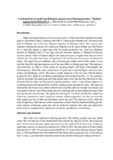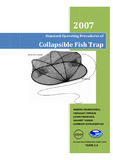Catch Analysis of Squid Trap Fishing in Coastal Area of Rayong Province, Thailand
Description
Bigfin reef squid (Sepioteuthis lessoniana Lesson, 1830) is one of the important economic squid in Indo-Pacific waters including in the Gulf of Thailand and Andaman Sea. The catch in the Gulf of Thailand was 4,728 tons (fisheries statistics of Thailand, 2013). The squid is also important commercial resource for small-scale fisheries and the major fishing gear that fishers use to catch this species is squid trap, with the annual production was 1,665 tons (fisheries statistics of Thailand, 2013). It has high value for domestic markets in Thailand. In Rayong province, Eastern Gulf of Thailand, Bigfin reef squid production is higher than other provinces indicates that the squid trap fishery is important to the livelihood and economic of small-scale fishers. The squid trap is a traditional type of fishing gear widely used in Thai waters. It was modified from fish trap that represent one of the most effective fishing gear type. This trap has a high selectivity in order to catch squids for targeting Bigfin reef squid (Chotiyapuita and Yamrungreung, 1998).The catch compositions of squid trap composed Bigfin reef squid 86% (Udom and Nunthapon, 2012). This trap is usually deployed in the day time with the fishing ground of 3-40 m depth. It is set floating individually with the float line (Fig. 3). The operation methods, first place the squid eggs and white plastic bags in the trap after that shooting the trap, followed with the sinker and flag pole for marking position. After 1-2 days fishers approach to the fishing ground and trap positions, the fisher hauling up the rope line by winch. The traps are retrieved by moved up to sea surface onboard and scoop the catch out through the entrance and keep squids in the box, then fisher change the new squid eggs and continue deploy the traps in the same position for next shooting. The squids from the trap are very fresh and still alive. Squid trap fishery has a potential to make a significant seafood in Rayong province, but there are very few study reports and lack of data and information about this gear. The objectives of this study the catch of squid trap, catch species, catch compositions, relation between squid and fishing ground. Catch analysis of Rayong squid trap will be useful for fisheries data base and underwater observations to understand the capture process and the trap efficiency in the future.
การอ้างอิง
Witanurawat, A., Boutson , A., Kaewnern , M., Ebata, K., & Arimoto, T. (2015). Catch Analysis of Squid Trap Fishing in Coastal Area of Rayong province, Thailand. SEAFDEC Technical Seminar 2015 (pp. 3-5). Samut Prakan: Training Department, Southeast Asian Fisheries Development Center.
เรื่อง
คอลเลกชัน
รายการที่เกี่ยวข้อง
แสดงรายการที่เกี่ยวข้องตามชื่อผู้แต่งผู้สร้างและเรื่อง
-
Standard Operating Procedures of Collapsible Fish Trap
Reungsivakul, Narong; Timkrub, Taweesak; Promjinda, Sayan; Yasook, Nakaret; Siriraksophon, Somboon (Training Department, Southeast Asian Fisheries Development Center, 2007)In early times, flowing water caused by tidal movement and changes in river and lake levels were probably used to trap fish behind rudimentary barriers, often made from sticks and stones. It is likely that early humans ... -
Coordination between Crab Trap and Crab Gill Nets Fisheries: Change and Adjustment of Fishing Gear for Responsible Fisheries Projects to Contribute Locally based Coastal Resource Management
Petchkamnerd, Jinda; Suanrattanachai, Phattareeya; Auimrod, Sayan (Training Department, Southeast Asian Fisheries Development Center, 2003)Crab fisheries in Tambol Pakklong composed of collapsible crab trap and crab gill net fishers. Collapsible crab trap fishers were classified into three sub-categories by size of wire. These were small sized wire, large ... -
Trap Fishing
Okawara, Masatake (Southeast Asian Fisheries Development Center, 1983-01)It is said that the demersal resources in coastal waters, particularly those in shallow waters and in flat sea-bottom areas, have already been over exploited. However, we can safely assume that there are many areas, even ...




